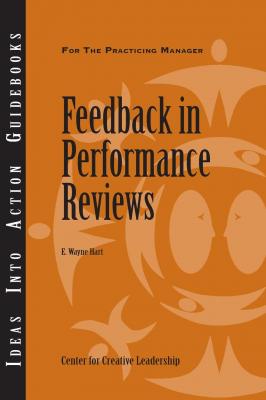Feedback in Performance Reviews. E. Wayne Hart
Чтение книги онлайн.
Читать онлайн книгу Feedback in Performance Reviews - E. Wayne Hart страница

AN IDEAS INTO ACTION GUIDEBOOK
Feedback in Performance Reviews
IDEAS INTO ACTION GUIDEBOOKS
Aimed at managers and executives who are concerned with their own and others’ development, each guidebook in this series gives specific advice on how to complete a developmental task or solve a leadership problem.
| LEAD CONTRIBUTOR | E. Wayne Hart |
| CONTRIBUTORS | John Fleenor |
| Pete Hammett | |
| Bertrand Sereno | |
| Stephanie Trovas | |
| Jim Wilson | |
| DIRECTOR OF ASSESSMENTS, TOOLS, AND PUBLICATIONS | Sylvester Taylor |
| MANAGER, PUBLICATION DEVELOPMENT | Peter Scisco |
| EDITOR | Stephen Rush |
| EDITOR | Karen Lewis |
| DESIGN AND LAYOUT | Joanne Ferguson |
| CONTRIBUTING ARTISTS | Laura J. Gibson |
| Chris Wilson, 29 & Company |
Copyright © 2011 Center for Creative Leadership.
All Rights Reserved. No part of this publication may be reproduced, stored in a retrieval system, or transmitted, in any form or by any means, electronic, mechanical, photocopying, recording, or otherwise, without the prior written permission of the publisher. Printed in the United States of America.
CCL No. 450
ISBN No. 978-1-60491-114-5
CENTER FOR CREATIVE LEADERSHIP
AN IDEAS INTO ACTION GUIDEBOOK
Feedback in Performance Reviews
E. Wayne Hart
THE IDEAS INTO ACTION GUIDEBOOK SERIES
This series of guidebooks draws on the practical knowledge that the Center for Creative Leadership (CCL®) has generated, since its inception in 1970, through its research and educational activity conducted in partnership with hundreds of thousands of managers and executives. Much of this knowledge is shared—in a way that is distinct from the typical university department, professional association, or consultancy. CCL is not simply a collection of individual experts, although the individual credentials of its staff are impressive; rather it is a community, with its members holding certain principles in common and working together to understand and generate practical responses to today’s leadership and organizational challenges.
The purpose of the series is to provide managers with specific advice on how to complete a developmental task or solve a leadership challenge. In doing that, the series carries out CCL’s mission to advance the understanding, practice, and development of leadership for the benefit of society worldwide. We think you will find the Ideas Into Action Guidebooks an important addition to your leadership toolkit.
Table of Contents
The Role of Feedback in a Review
A Closer Look at Authoritative Feedback
A Closer Look at Impact Feedback
Comparing Authoritative and Impact Feedback
When to Use Authoritative and Impact Feedback
Framework for a Feedback Message
EXECUTIVE BRIEF
Effective feedback is one of the most important components of successful performance reviews. Feedback is assessment data that either supports continuing to perform in some manner or targets a desirable change. This guidebook will help you provide performance review feedback that will be well received. It explains three feedback principles and four different types of feedback. Each of these four types is effective when used at the right time and for the right reasons, and they can be used in combination. This guidebook will help you understand when to use the different types of feedback and how to frame a complete feedback message. The rest is practice.
Feedback Gone Awry
Brenda was an enthusiastic, bright, and talented computer technician. Her manager, Ethan, saw a great future for her at the Community Health Center, where she supported medical staff in the Women’s Health Department. Despite Brenda’s track record of quickly solving system user problems, there had been complaints about her “brash” attitude. Her internal customers felt belittled by her use of phrases like “user error,” “what’s your problem?” and “why didn’t you…?”
At their annual performance review, Ethan coached Brenda with a little feedback on how to better word things. “Instead of ‘user error,’ try saying, ‘entry glitch.’”
“I don’t see why I should have to mince words,” she protested. “They don’t listen to me anyway. They don’t want to learn anything—they just want a quick fix.”
Ethan was more than a little discouraged by Brenda’s defensiveness, but he recognized that her edgy response to him was exactly the type of behavior that was alienating the medical staff. He tried another approach, explaining, “It’s about customer service. Try speaking in their language. For example, instead of asking, ‘What is your problem with the computer?’ ask, ‘What are the symptoms?’”
“I’ve told some of them three